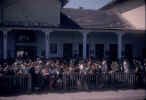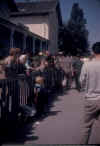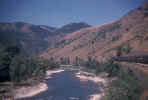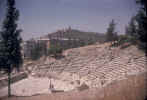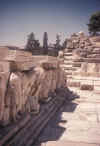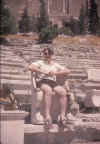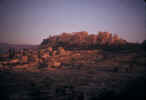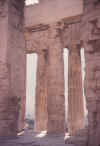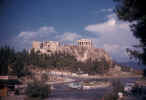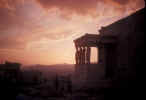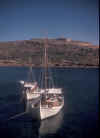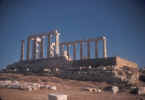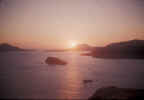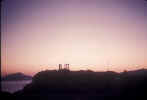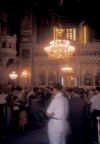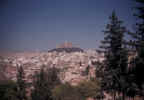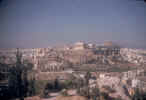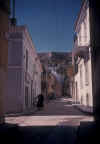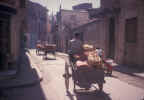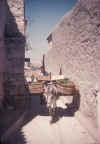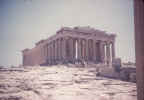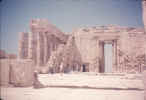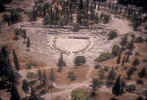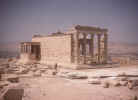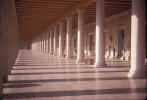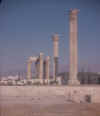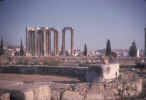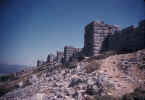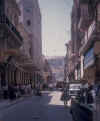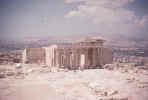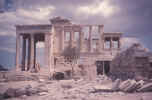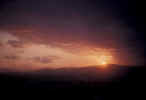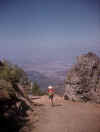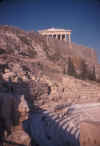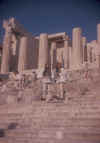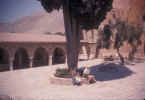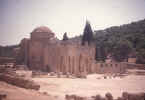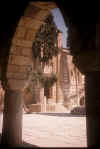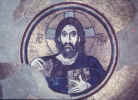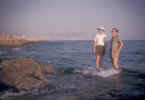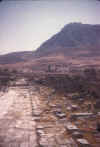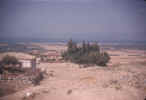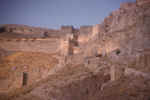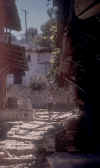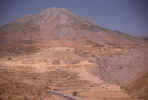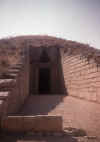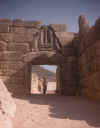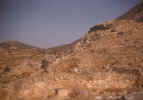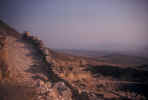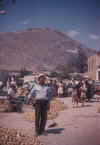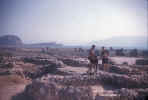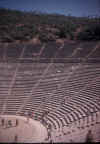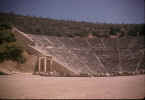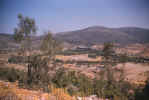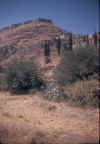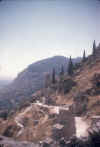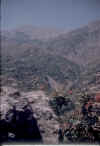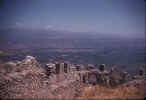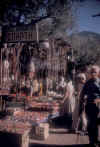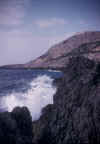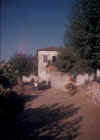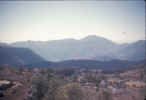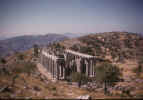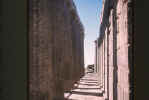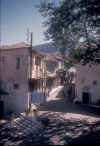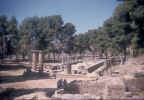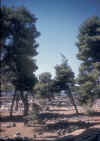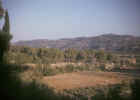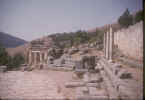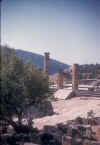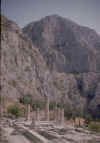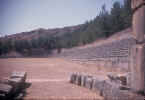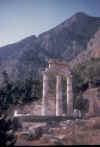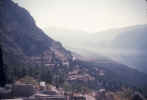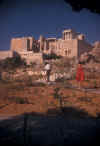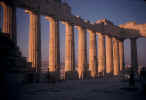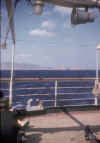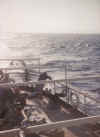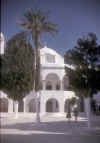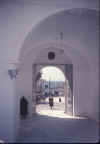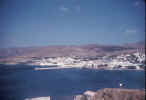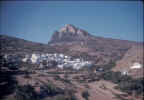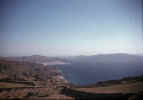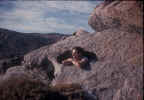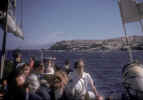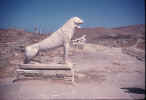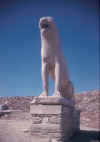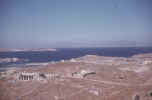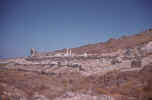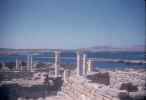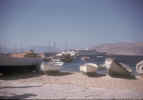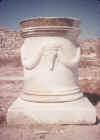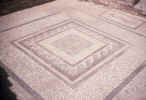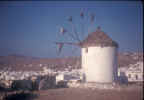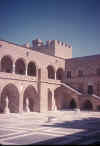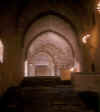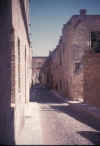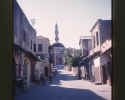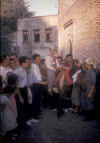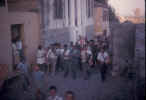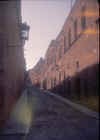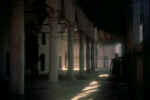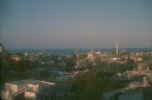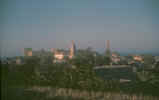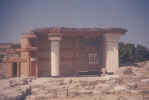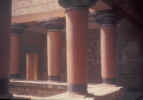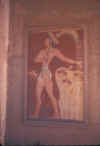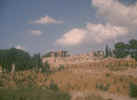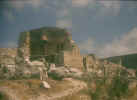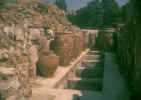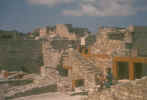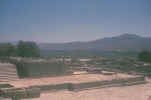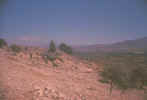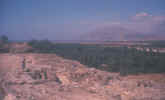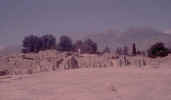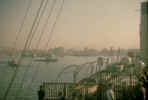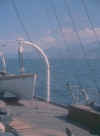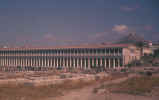Itinerary of Greek trip August-September 1961
This itinerary is based on John's 1961 diary.
Click on any thumbnail to see a full screen image - use your browser's 'back' button to return to this page
Saturday 05/08/61
London – Dover
Sunday 06/08/61
Dover – Ostend – Köln – Heidelberg – München (train)
Monday 07/08/61
München – Salzburg – Ljubljana – Zagreb
Tuesday 08/08/61
Brod – Belgrade – Kragujevac – Kraljevo – Kosovska Mitrovica – Skopje – Gevgelija (frontier)
The stretch Kragujevac – Skopje was not the route taken by most through-trains and it went through some very remote, rugged and poor country.
001 Kragujevac stn 002 Kragujevac 003
Wednesday 09/08/61
Eidhomini – Thessaloniki – Larissa – Thebes – Athens (arr.
12.30). Visit Post-Office, climb
Lykabettos in heat, then get access to the apartment we had been lent.
Thursday 10/08/61
Athens: visit Arch of
Hadrian, Theatres of Dionysus and Herodes Atticus;
after lunch and siesta, bought hats and went round ancient Agora,
Theseium and watch sunset from Areopagus.
004 Theatre of Dionysus 005 T of D 006 T of D + John 007 Acropolis
Friday 11/08/61
Morning
at embassy and practical matters;
Afternoon,
start on the Acropolis; Evening see “Iphigenia in Aulis” at
Theatre of Herodes
Atticus.
010 Parthenon 011 Parthenon 012 Erechtheum
Saturday 12/08/61
To Sounion and back by bus: spent day swimming, exploring and getting an idea of local geography (we could see Euboia, Kea and the Argolid, but no further because of haze); watched sunset before returning.
013 Sunion 014 015 016
Sunday 13/08/61
Athens: morning in
Orthodox
Cathedral (Mitropoleos), watched a
wedding; afternoon at Areopagus,
Pnyx and Hill of Philopappos.
017 Cathedral wedding
Monday 14/08/61
Morning and late afternoon on Acropolis.
018 Lycabettos 019 Acropolis 020 Streets 021 Streets 022 Streets 023 Acropolis
024 Acropolis 025 Herodes Atticus 026 Erectheum
Morning at the Kerameikos, Street of Tombs and Sacred and Dipylon Gates, interesting archaeological sites; Afternoon to the Agora again and museum in the Stoa of Attalus (see #319 Stoa of Attalus)
Most of the day in National Archaeological Museum, (where we ran into Colin Renfrew, ‘ex-President of Union’ in my diary). impressive collection of Mycenian and Minoan objects (eg Mask of Agamemnon) which overshadowed the classical sculptures. Afterwards Temple of Zeus and ancient Stadium.
027 N A Museum 028 T of Z 029 T of Z
Thursday 17/08/61
By bus via Daphni and Eleusis
to Khani Kaza to investigate site of 4th century frontier
fort of Erythrai (very well preserved fortifications);
030 Erythrai
The
frontier was that between Attica and the Thebans;
in the Peloponnesian War
Thebes was allied with
Then hitch-hiked to site of ancient town of Plataia. One of those who gave us a lift was a local doctor who alarmed us with talk of war over Berlin - the Berlin Wall was begun 13/08/61.
Back (hitch-hiking and bus)..
Friday 18/08/61
Morning John went to Epigraphic and Numismatic Museums, Derek was sketching on
Acropolis. Afternoon Byzantine Museum, Library of Hadrian, Roman Agora and
Melitus quarter;
Between Pnyx and Areopagus. splendid sunset
viewed from Acropolis.
031 Streets 032 Acropolis 033 Erechtheum 034 Sunset
Saturday 19/08/61
Bus to Pendelis Monastery, then on foot skirting summit of Mt. Pentelikos (the summit itself had a large and well-guarded military installation) then across highish country before dropping down to Nea Makri near Marathon. Here in 490 the Athenians beat back a Persian army attempting to land from the sea. The dramatist Aeschylus was in the army.
035 To Marathon
We estimated we’d done at least 16 miles out of the statutory 26 (and 385 yards). Back to Athens by bus.
Sunday 20/08/61
Morning on the Acropolis;
Afternoon.
to suburb of Nea Smyrni to visit an acquaintance of mine, Clea, but she was out. Evening
saw a performance of “Nausicaa” (Peggy
Glanville-Hicks) in Theatre of
Herodes Atticus.
036 037
Monday 21/08/61
We catch up with Clea and had enormous lunch with her family;
evening a folk-dancing and music show in Peiraios.
Tuesday 22/08/61
With Clea to Daphni Monastery;
101 Daphni with Clea 102 Daphni 103 Daphni 103a Pantocretor
Then
by bus to Peiraios where we explored the classical harbours!
104
Wednesday 23/08/61
To Corinth by train in afternoon via
Eleusis, Megara and bridge over Corinth Canal.
Thursday 24/08/61
On foot to ancient Corinth
(Palaiokorinthos)
which is
about 8 km from modern Corinth and was abandoned after an earthquake in the
1880s. We climbed its acropolis, Akrokorinthos (1800 ft) in
sweltering heat; it has extensive
fortifications (Byzantine, Frankish, Venetian and Turkish) around summit and
(of course) magnificent views.
105 Acrocorinth 106 Acrocorinth view 107 Acrocorinth
Friday 25/08/61
Corinth to village close to site of ancient Mycenai by train;
108 Kharvati(?)
Afternoon at Mycenai, its citadel first, then down to the Lion Gate and the site that Schliemann made famous; slept out, on concrete roof of a hotel (Iphegenia in Aulis), for first time (for me at least)
109 Citadel 110 Atreus Treasury 111 Lion gate 113 114
Saturday 26/08/61
Mycenai to Argos (on foot) - memorable for me because I was ambushed by dogs, whose ‘owner’ called them of by pelting them with rocks.
115 Argos market
Afternoon bus to another Mycenaian site, Tiryns (massive ramparts, but on a level plain close to the sea).
116 Tiryns
Then on to Navplion (on foot?), the first capital of
newly independent Greece 1827-1834.
Sunday 27/08/61
Navplion to Epidavros with its magnificent theatre, also a
sanctuary-hospital (the museum had details of cures inscribed on tablets);
then back to Navplion (bus).
117 Epidavrous 118 119 from afar
Monday 28/08/61
Navplion – Argos – Sparta.
120 Location unknown!
Tuesday 29/08/61
Sparta to Mystra (2000 ft) apparently on foot; it is medieval, founded by the crusader, Guillaume de Villehardouin, and much more has survived than of classical towns; From 1261 to 1460 Mystra was the capital of the Peloponnese (then known as the Morea) and an important centre of scholarship.
121 Mystra 122 123 Mt Taygetos?? 124 Lakedaimon basin from Mystra
back by way
of the monastery of Perivleptos.
125 Market 126
Wednesday 30/08/61
Taxi Sparta – Kalamata over Mt. Taygetos range - rising, we estimated, to about 6000 ft. The taxi cost the (to us) immense sum of 110 drakhmai, but bus fares back to Tripolis and then via Megalopolis to Kalamata would have been just as expensive.
Afternoon on to the modern town of Pylos.
127 Pylos 128
This
is at the south end of the almost enclosed bay of Navarino. Classical
Pylos was at the north end of the bay, on a promontory facing the sea and
close to the channel that separates the mainland from the island of Sphakteria;
in classical times the Homeric Pylos, home of Nestor, was assumed to be
somewhere north of the bay too, and this has been proved correct by the
excavation of a Mycenian site there. at the
south end of the almost enclosed
Thursday 31/08/61
Walked, partly along beach, to north end of Navarino Bay,
and crossed to
Sphakteria
The
channel can now be crossed by wading, whereas it took ships in classical times; this may account for the shift of the main settlement to the
south end of the bay. On
Sphakteria
we explored the rocks, dunes and lagoons north of the
bay. Back to Pylos in evening.
Friday 01/09/61
Pylos to the excavated Mycenian site north of the bay (bus) a bit NE of the village of Khora, and now renamed ‘Nestor’.
129 Nestor tomb
Back to Pylos in evening.
130 Pylos 131 Harbour
Saturday 02/09/61
Pylos to modern Messini (a bit west of Kalamata. by bus), then walked / hitch-hiked north to the village of Mavrommati which was reported to be on the site of the classical town of Messini. Mavrommati means ‘black eye’, and the ‘black eye’ in question was a spring gushing vigorously out of a black hole in a rock. In Turkish (which I suspect got it from Arabic) the same word can mean both ‘eye’ and ‘spring’ or ‘source’ and this link is reflected in Greek place names. Investigation showed that the water came through a tunnel from an ancient Greek or, more probably, Roman aqueduct.
We
explored the well-preserved site of ancient Messini and
climbed
132 Old Messini
In evening to Valyra
by bus, which had no hotels or cafes at the time (a sign of how much ‘off the beaten
track’ we were!). We were
surrounded by almost the entire village when we arrived and a farmer, by a
process of negotiation mysterious to us, ‘won’ the right to entertain
us. He and his wife gave up
their own bedroom for us; the
living quarters were reached by a ladder, which, I think, means that the
ground floor was a stall for animals.
Sunday 03/09/61
We offered to pay our hosts - but they refused. They did ask that we take their picture and send a copy - which we did.
133 Our hosts 134 Their house
Valyra to Megalopolis (on foot and hitching).
Afternoon by bus to highland village of Andritsena.
Monday 04/09/61
Andritsena to the temple of Bassai on a high plateau and back by taxi. Bassai is of the same basic design as the Parthenon but much better preserved. The reason for the taxi was that we wanted to get back to Andritsena to catch the bus; on foot it would have taken us 3 hours each way.
135 Bassai 136 137
and back to Andritsena
138 Andritsena
Afternoon by bus from Andritsena to Pyrgos on the west coast of the Peloponnese;
then bus further inland to Olympia. The
pleasant valley site where the original Olympic games had been held (nothing
to do with Mt. Olympos!).
Tuesday 05/09/61
Olympia all day.
I
wrote that it seemed to have combined the functions of ‘Lourdes, Wembley,
Geneva and Westminster Abbey’.
201 Olympia 202 203
Wednesday 06/09/61
From Olympia by train via Patrai
to Aigion (pronounced
‘Eyyon’) on the south coast of the Gulf of Corinth.
After dark crossed the gulf by ferry to Itea on the north coast, the
port for Delphi.
Thursday 07/09/61
Itea by bus up to Delphi at 1880 ft.,
the pre-eminent religious site of ancient
204 Delphi 205 206 207 208 209
Its
importance centred on the Delphic Oracle – a priestess called the Pythia
who answered questions “in a state of frenzy induced by means not now
ascertainable with certainty” [Oxford Classical Dictionary]. She
was consulted by people and states from all over
Friday 08/09/61
Morning in Delphi; afternoon
hitch-hiked to Athens via Arakhova, Levadia and Thebes.
Saturday 09/09/61
Athens
Sunday 10/09/61
Athens, mainly on and around the Acropolis, including during a
thunderstorm.
210 Acropolis 212 Acropolis
Monday 11/09/61
By boat from Peiraios to island of Tinos, leaving at 1.00 p.m., passing Sounion,
213 Sounion 214
sailing between Kea and Kythnos and stopping at Ermoupolis on Syros; final crossing Syros to Tinos done after sunset.
Tuesday
12/09/61
Morning explored town of Tinos, then in the afternoon climbed to Venetian fortress
Exoburgo on peak of the island’s mountain (1760 ft.).
215 Tinos 216 217 218 219 220
Wednesday 13/09/61
Tinos, swimming and exploring probable classical sites outside the
town; evening cross by boat to
Myconos.
Thursday 14/09/61
Explored town and island of Myconos.
Friday 15/09/61
Crossed for the morning to the island of Delos - with its very large area of classical (and later) ruins to explore.
221 To Delos 222 Delos 223 224 225 226
Afternoon
climbed to highest point on Myconos, with splendid views of
227 Myconos
Saturday 16/09/61
Morning on Delos again; afternoon. walking on Myconos; evening board boat for Rhodes
228 Delos 229 230 Myconos
Sunday 17/09/61
Boat
stopped at Kalymnos in dark, at dawn we round the northern tip of Kos and stop
at harbour of Kos town, with opposite the rocky and grim (in this light)
peninsula of Kızıl Burun and the site of Halicarnassos;
then south and around the precipitous peninsula of Cnidos, south of the
island of Syme and, still in the morning, into harbour of Rhodes at northern
tip of the island. Rhodes
is tree-covered – in stark
contrast to the coast of
231 232 233
In afternoon walked round old town, visited Museum and then entered
Turkish quarter where we were invited to join the celebrations of a Turkish
circumcision (boy about seven, in best suit on donkey), but language of
ceremony apparently Greek.
234 Turkish quarter 235 Circ. ceremony 236
Monday 18/09/61
Morning
John went by bus to Lindos, a classical site about halfway down the east coast
of Rhodes (Derek hitch-hiked to join him there later. Sea
water had got into his camera (probably on one of the crossings between
Myconos and
Spent the day exploring and photographing in and around town of Rhodes.
301 302 303 304
This included a visit to a mosque.
Inside the date on the
calendar was the year 1377. This
was not, as we probably thought at the time, a hijra
date – if it had been, the Gregorian equivalent would have been 1957 –
but an example of the Ottoman solar, Julian calendar, adopted in 1789;
to convert its years to Gregorian years add 584 (1377 + 584 = 1961✓).
Turkey adopted our Gregorian calendar (though with indigenous
Middle-Eastern month names) at the end of 1925, but apparently the clergy of
this mosque had not heard of or disapproved of Atatürk’s reforms.
(I regret I did not note down what script
was used in the mosque.)
Wednesday 20/09/61
The good ship Andros, built
1908, Glasgow (I think), didn’t get away until 6.15 a.m.
It called at Chalki (a bare rock in the sea west of Rhodes), Karpathos
and Kassos in the Dodecanese and Sitia (town on the northern coast in the far
east of Crete), before getting into Cretan Agios Nikolaos at midnight.
Not much seemed to be open, so we accepted a café owner’s offer of
his floor to sleep on…
Thursday 21/09/61
…little knowing that the café was home to rats as well. Undisturbed we were on the road (hitch-hiking) for the Minoan site of Gournia by 8.00 a.m., a small palace and the remains of a network of town streets. .We would probably have made more of it if we had been to Knossos first! Then a spectacular bus ride along the north coast through wild mountains and later tropical banana groves to Heraklion, the largest town of Crete. We drove in to a hero’s welcome of massed crowds in festive clothes. Sadly they were not for us but preparations for the next day, which marked the thousandth anniversary of the liberation of Crete from the Arabs by the future Byzantine Emperor Nikephoros Phokas. (But oddly the historians of Byzantium which I later studied date the end of the Cretan campaign to March 961)
Friday 22/09/61
Knossos is 10 minutes bus ride from Heraklion, in unspectacular country, but a very spectacular site. Knossos was dug and restored by the English archaeologist Sir Arthur Evans, controversially restored in the opinion of many, especially of non-British. (‘Eez very eenglish, zees civilisation’ we were told by two Frenchmen).
305 306 307 308 309 310
311 312
I think we came to
the conclusion that it had been right to restore the architecture in the way
he had: after all the Palace of
Minos was both a labyrinth and had
stood four-five storeys high in places, and the impact of that was
impressively conveyed. We were
less sure about the restoration of the frescoes and other art –-the details
of clothing, the bull-leaping ceremony -- which seemed based on very
fragmentary evidence (however
they satisfied Mary Renault, who was no mean classicist). We looked at
them in
the Heraklion Museum, though replicas are in
situ at the Knossos site.
Saturday 23/09/61
Caught bus to
Phaistos, the next most important Minoan site, on the
south coast; side-trips to Agia
Triada (Minoan villa) and Gortyn (classical inscription of law code).
313 314 315 316
Sunday 24/09/61
Most of the day at Knossos again – it is an immense site – and
walked back to Heraklion.
Monday 25/09/61
Half of morning at Heraklion Museum again.
Then catch ship (bigger than the earlier ones) at 12.00 noon for
Athens. Called at Rethymni and
Khania in western Crete before setting off northwards under a bright full
moon.
317 318
Tuesday 26/09/61
Dawn close to coast of Attica. Spent
most of day preparing for journey home (tickets, shopping etc).
Wednesday 27/09/61
Last day....
Morning in the National Archaeological Museum (which we had visited on 16th August) for a second look at the Cretan and Mycenian material.
Afternoon, last visit to the Acropolis, and a trip to the Stoa of Attalus which we had visited on 15th August. (back to 15th August)
After a good meal we were at the station by 9.00 p.m. Train for north left at 10.30 p.m.
Thursday 28/09/61
At dawn train has just passed Larissa and we skirt the flanks of Mt.
Olympos. Thessaloniki by 9.30
a.m., frontier at 10.45. Left
Gevgelija at 1.30 p.m., Skopje by 4.30, sundown c.5.30.
Friday 29/09/61
Sunrise c.5.30 a.m. between Sremska Mitrovica and Vinkovci, ie already in Croatia. Novska, Sisak, Zagreb. It was here that the train started to pull out of the station suddenly, when many students were still on the platform. I was among the last to swarm aboard, and, to my horror, found I was hanging on to the outside of a locked door... It felt like a lifetime but perhaps it was only a minute or two before someone passed me out a key...
Jesenice (frontier
with Austria) at 2.30 p.m., Salzburg by 8.15pm.
JHM, 21.vii.11
